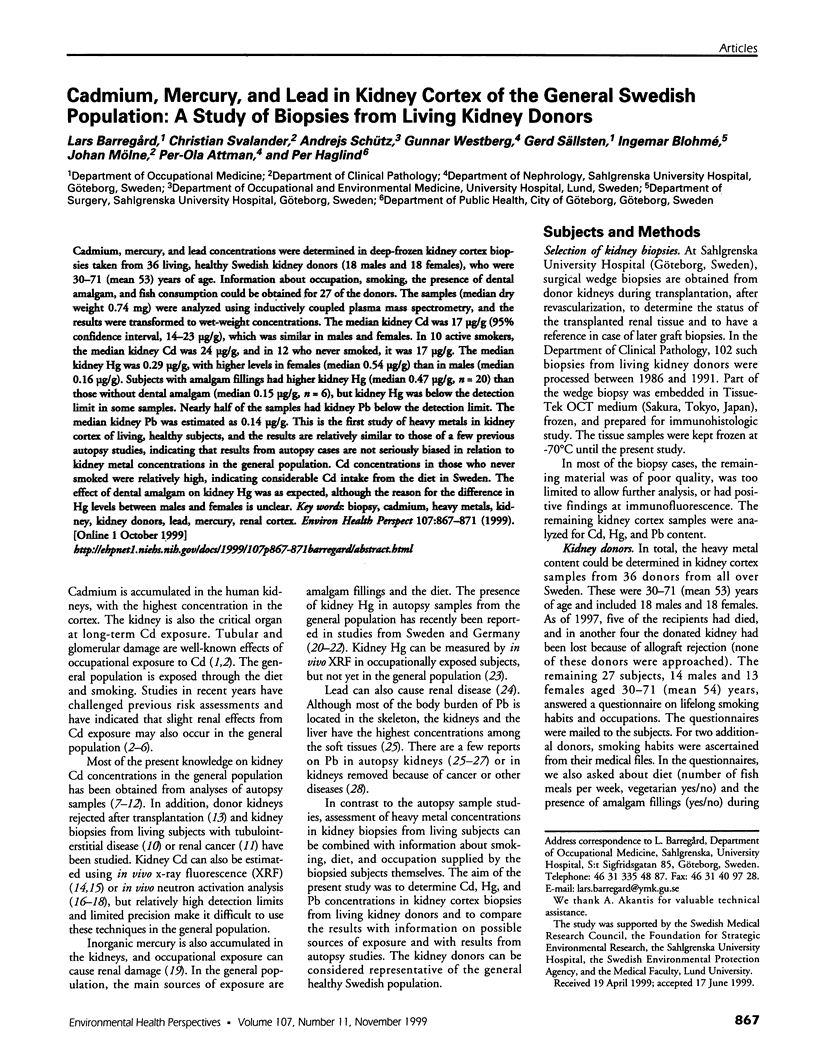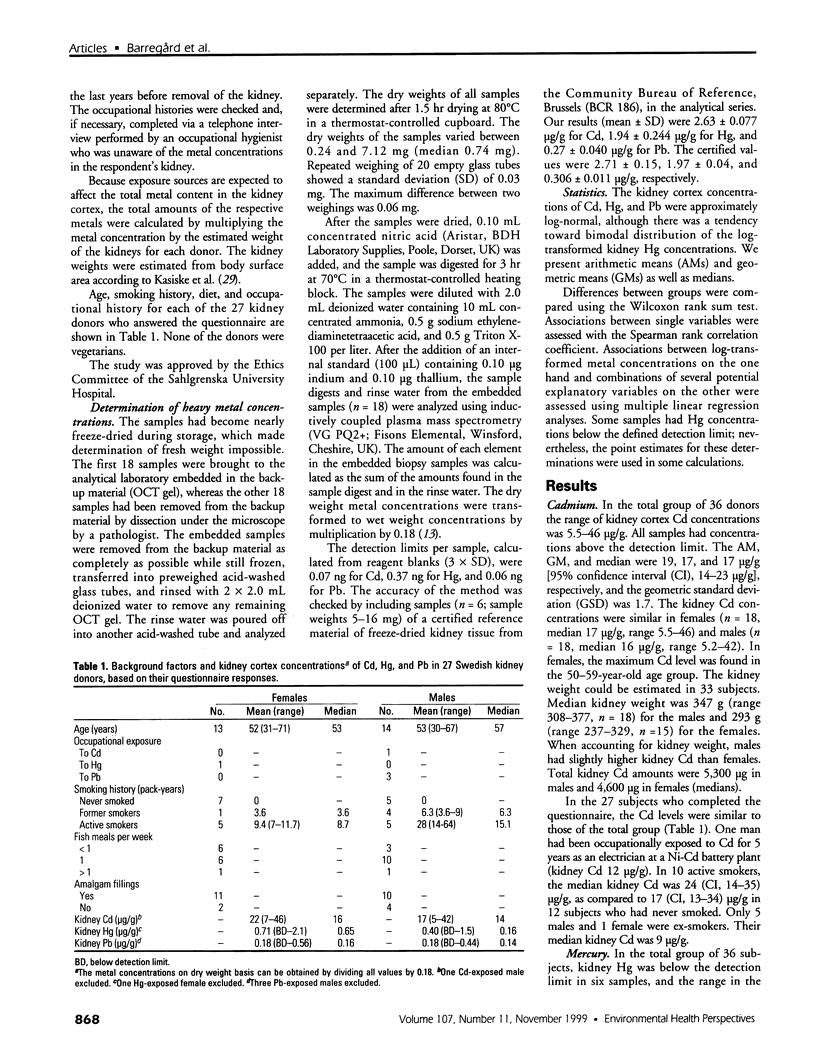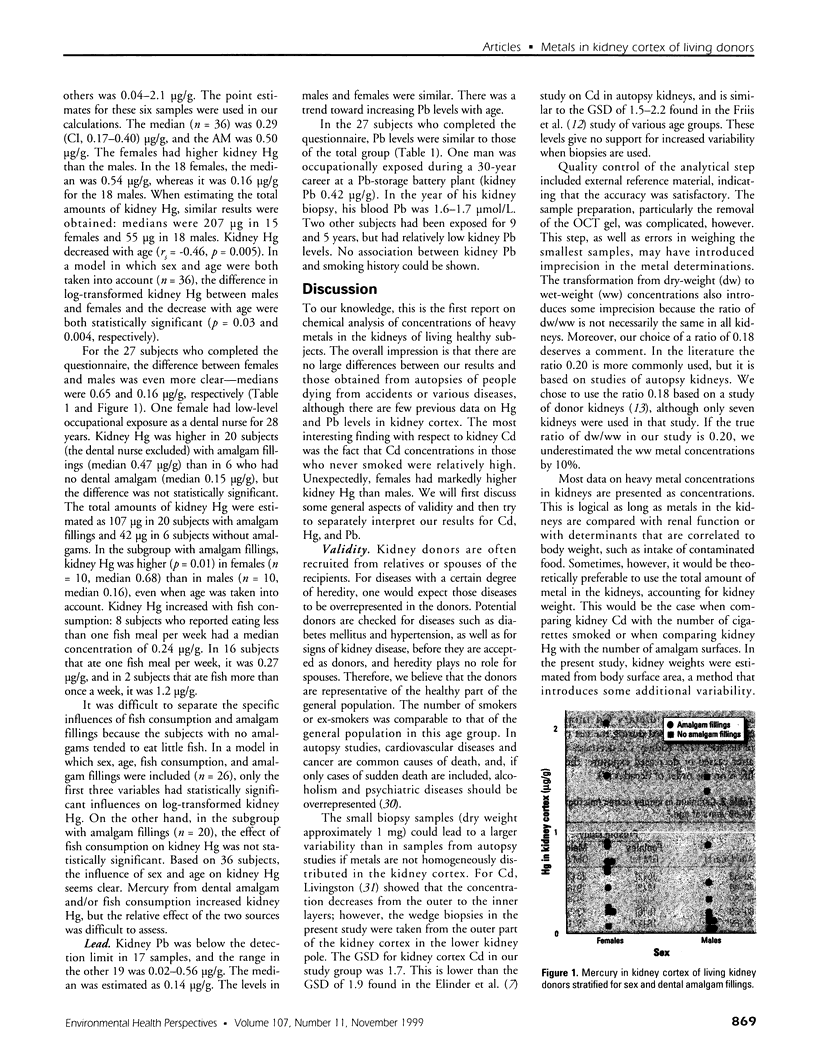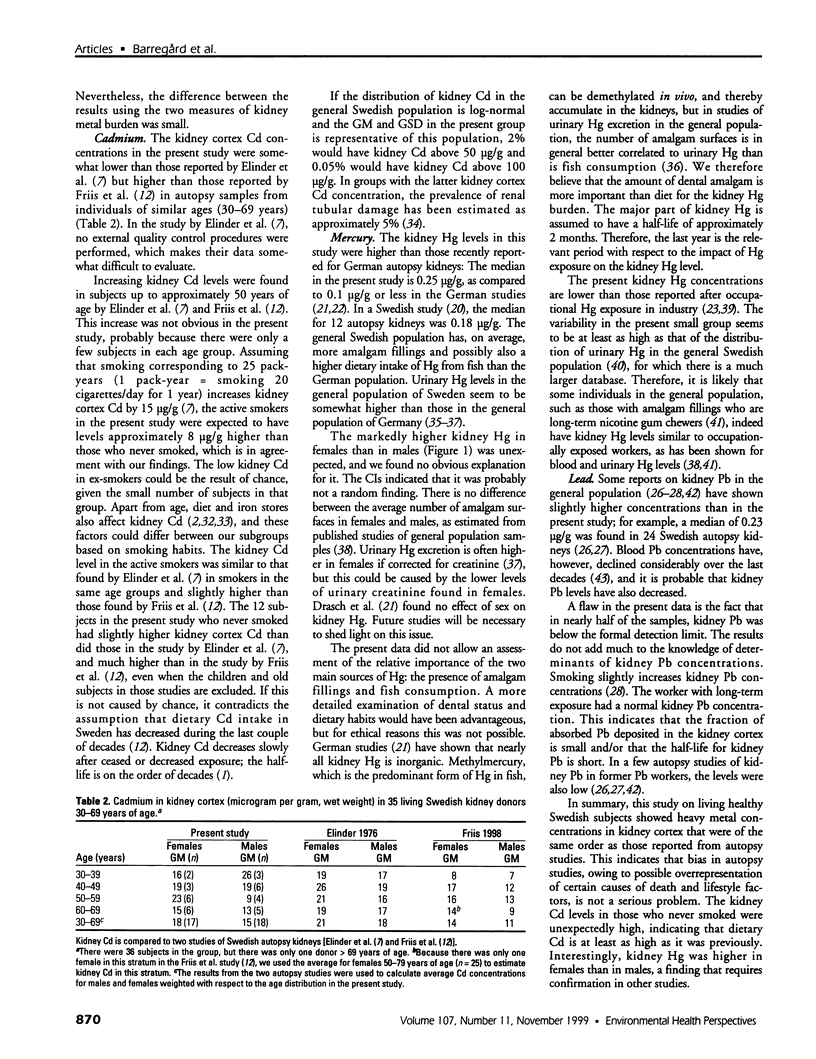Abstract
Cadmium, mercury, and lead concentrations were determined in deep-frozen kidney cortex biopsies taken from 36 living, healthy Swedish kidney donors (18 males and 18 females), who were 30-71 (mean 53) years of age. Information about occupation, smoking, the presence of dental amalgam, and fish consumption could be obtained for 27 of the donors. The samples (median dry weight 0.74 mg) were analyzed using inductively coupled plasma mass spectrometry, and the results were transformed to wet-weight concentrations. The median kidney Cd was 17 micrograms/g (95% confidence interval, 14-23 micrograms/g), which was similar in males and females. In 10 active smokers, the median kidney Cd was 24 micrograms/g, and in 12 who never smoked, it was 17 micrograms/g. The median kidney Hg was 0.29 micrograms/g, with higher levels in females (median 0.54 micrograms/g) than in males (median 0.16 micrograms/g). Subjects with amalgam fillings had higher kidney Hg (median 0.47 micrograms/g, n = 20) than those without dental amalgam (median 0.15 micrograms;g/g, n = 6), but kidney Hg was below the detection limit in some samples. Nearly half of the samples had kidney Pb below the detection limit. The median kidney Pb was estimated as 0. 14 micrograms/g. This is the first study of heavy metals in kidney cortex of living, healthy subjects, and the results are relatively similar to those of a few previous autopsy studies, indicating that results from autopsy cases are not seriously biased in relation to kidney metal concentrations in the general population. Cd concentrations in those who never smoked were relatively high, indicating considerable Cd intake from the diet in Sweden. The effect of dental amalgam on kidney Hg was as expected, although the reason for the difference in Hg levels between males and females is unclear.
Full text
PDF




Images in this article
Selected References
These references are in PubMed. This may not be the complete list of references from this article.
- Akesson I., Schutz A., Attewell R., Skerfving S., Glantz P. O. Status of mercury and selenium in dental personnel: impact of amalgam work and own fillings. Arch Environ Health. 1991 Mar-Apr;46(2):102–109. doi: 10.1080/00039896.1991.9937436. [DOI] [PubMed] [Google Scholar]
- Barregård L., Sällsten G., Conradi N. Tissue levels of mercury determined in a deceased worker after occupational exposure. Int Arch Occup Environ Health. 1999 May;72(3):169–173. doi: 10.1007/s004200050356. [DOI] [PubMed] [Google Scholar]
- Barregård L., Sällsten G., Järvholm B. People with high mercury uptake from their own dental amalgam fillings. Occup Environ Med. 1995 Feb;52(2):124–128. doi: 10.1136/oem.52.2.124. [DOI] [PMC free article] [PubMed] [Google Scholar]
- Berglund M., Akesson A., Nermell B., Vahter M. Intestinal absorption of dietary cadmium in women depends on body iron stores and fiber intake. Environ Health Perspect. 1994 Dec;102(12):1058–1066. doi: 10.1289/ehp.941021058. [DOI] [PMC free article] [PubMed] [Google Scholar]
- Brune D., Nordberg G., Wester P. O. Distribution of 23 elements in the kidney, liver and lungs of workers from a smeltery and refinery in North Sweden exposed to a number of elements and of a control group. Sci Total Environ. 1980 Sep;16(1):13–35. doi: 10.1016/0048-9697(80)90100-x. [DOI] [PubMed] [Google Scholar]
- Buchet J. P., Lauwerys R., Roels H., Bernard A., Bruaux P., Claeys F., Ducoffre G., de Plaen P., Staessen J., Amery A. Renal effects of cadmium body burden of the general population. Lancet. 1990 Sep 22;336(8717):699–702. doi: 10.1016/0140-6736(90)92201-r. [DOI] [PubMed] [Google Scholar]
- Börjesson J., Barregård L., Sällsten G., Schütz A., Jonson R., Alpsten M., Mattsson S. In vivo XRF analysis of mercury: the relation between concentrations in the kidney and the urine. Phys Med Biol. 1995 Mar;40(3):413–426. doi: 10.1088/0031-9155/40/3/006. [DOI] [PubMed] [Google Scholar]
- Börjesson J., Bellander T., Järup L., Elinder C. G., Mattsson S. In vivo analysis of cadmium in battery workers versus measurements of blood, urine, and workplace air. Occup Environ Med. 1997 Jun;54(6):424–431. doi: 10.1136/oem.54.6.424. [DOI] [PMC free article] [PubMed] [Google Scholar]
- Elinder C. G., Lind B., Kjellström T., Linnman L., Friberg L. Cadmium in kidney cortex, liver, and pancreas from Swedish autopsies. Estimation of biological half time in kidney cortex, considering calorie intake and smoking habits. Arch Environ Health. 1976 Nov-Dec;31(6):292–302. doi: 10.1080/00039896.1976.10667239. [DOI] [PubMed] [Google Scholar]
- Elinder C. G., Nordberg M., Palm B. Is cadmium released from metallothionein in rejected human kidneys? Biol Met. 1990;2(4):219–222. doi: 10.1007/BF01141363. [DOI] [PubMed] [Google Scholar]
- Ellis K. J., Vartsky D., Zanzi I., Cohn S. H., Yasumura S. Cadmium: in vivo measurement in smokers and nonsmokers. Science. 1979 Jul 20;205(4403):323–325. doi: 10.1126/science.377488. [DOI] [PubMed] [Google Scholar]
- Ellis K. J., Yuen K., Yasumura S., Cohn S. H. Dose-response analysis of cadmium in man: body burden vs kidney dysfunction. Environ Res. 1984 Feb;33(1):216–226. doi: 10.1016/0013-9351(84)90018-5. [DOI] [PubMed] [Google Scholar]
- Flanagan P. R., McLellan J. S., Haist J., Cherian G., Chamberlain M. J., Valberg L. S. Increased dietary cadmium absorption in mice and human subjects with iron deficiency. Gastroenterology. 1978 May;74(5 Pt 1):841–846. [PubMed] [Google Scholar]
- Friis L., Petersson L., Edling C. Reduced cadmium levels in human kidney cortex in sweden. Environ Health Perspect. 1998 Apr;106(4):175–178. doi: 10.1289/ehp.98106175. [DOI] [PMC free article] [PubMed] [Google Scholar]
- Gerhardsson L., Brune D., Nordberg G. F., Wester P. O. Distribution of cadmium, lead and zinc in lung, liver and kidney in long-term exposed smelter workers. Sci Total Environ. 1986 Apr;50:65–85. doi: 10.1016/0048-9697(86)90352-9. [DOI] [PubMed] [Google Scholar]
- Gerhardsson L., Englyst V., Lundström N. G., Nordberg G., Sandberg S., Steinvall F. Lead in tissues of deceased lead smelter workers. J Trace Elem Med Biol. 1995 Oct;9(3):136–143. doi: 10.1016/s0946-672x(11)80037-4. [DOI] [PubMed] [Google Scholar]
- Hardell L., Wing A. M., Ljungberg B., Dreifaldt A. C., Degerman A., Halmans G. Levels of cadmium, zinc and copper in renal cell carcinoma and normal kidney. Eur J Cancer Prev. 1994 Jan;3(1):45–48. doi: 10.1097/00008469-199401000-00006. [DOI] [PubMed] [Google Scholar]
- Järup L., Berglund M., Elinder C. G., Nordberg G., Vahter M. Health effects of cadmium exposure--a review of the literature and a risk estimate. Scand J Work Environ Health. 1998;24 (Suppl 1):1–51. [PubMed] [Google Scholar]
- Järup L., Carlsson M. D., Elinder C. G., Hellström L., Persson B., Schütz A. Enzymuria in a population living near a cadmium battery plant. Occup Environ Med. 1995 Nov;52(11):770–772. doi: 10.1136/oem.52.11.770. [DOI] [PMC free article] [PubMed] [Google Scholar]
- Kasiske B. L., Umen A. J. The influence of age, sex, race, and body habitus on kidney weight in humans. Arch Pathol Lab Med. 1986 Jan;110(1):55–60. [PubMed] [Google Scholar]
- Langworth S., Elinder C. G., Göthe C. J., Vesterberg O. Biological monitoring of environmental and occupational exposure to mercury. Int Arch Occup Environ Health. 1991;63(3):161–167. doi: 10.1007/BF00381563. [DOI] [PubMed] [Google Scholar]
- Lindqvist B., Nyström K., Stegmayr B., Wirell M., Eriksson A. Cadmium concentration in human kidney biopsies. Scand J Urol Nephrol. 1989;23(3):213–217. doi: 10.3109/00365598909180844. [DOI] [PubMed] [Google Scholar]
- Livingston H. D. Measurement and distribution of zinc, cadmium, and mercury in human kidney tissue. Clin Chem. 1972 Jan;18(1):67–72. [PubMed] [Google Scholar]
- Nilsson U., Schütz A., Skerfving S., Mattsson S. Cadmium in kidneys in Swedes measured in vivo using X-ray fluorescence analysis. Int Arch Occup Environ Health. 1995;67(6):405–411. doi: 10.1007/BF00381053. [DOI] [PubMed] [Google Scholar]
- Nylander M., Weiner J. Mercury and selenium concentrations and their interrelations in organs from dental staff and the general population. Br J Ind Med. 1991 Nov;48(11):729–734. doi: 10.1136/oem.48.11.729. [DOI] [PMC free article] [PubMed] [Google Scholar]
- Perola M., Vuori E., Penttilä A. Abuse of alcohol in sudden out-of-hospital deaths in Finland. Alcohol Clin Exp Res. 1994 Apr;18(2):255–260. doi: 10.1111/j.1530-0277.1994.tb00010.x. [DOI] [PubMed] [Google Scholar]
- Staessen J. A., Lauwerys R. R., Ide G., Roels H. A., Vyncke G., Amery A. Renal function and historical environmental cadmium pollution from zinc smelters. Lancet. 1994 Jun 18;343(8912):1523–1527. doi: 10.1016/s0140-6736(94)92936-x. [DOI] [PubMed] [Google Scholar]
- Staessen J., Amery A., Bernard A., Bruaux P., Buchet J. P., Claeys F., De Plaen P., Ducoffre G., Fagard R., Lauwerys R. R. Effects of exposure to cadmium on calcium metabolism: a population study. Br J Ind Med. 1991 Oct;48(10):710–714. doi: 10.1136/oem.48.10.710. [DOI] [PMC free article] [PubMed] [Google Scholar]
- Strömberg U., Schütz A., Skerfving S. Substantial decrease of blood lead in Swedish children, 1978-94, associated with petrol lead. Occup Environ Med. 1995 Nov;52(11):764–769. doi: 10.1136/oem.52.11.764. [DOI] [PMC free article] [PubMed] [Google Scholar]
- Svartengren M., Elinder C. G., Friberg L., Lind B. Distribution and concentration of cadmium in human kidney. Environ Res. 1986 Feb;39(1):1–7. doi: 10.1016/s0013-9351(86)80002-0. [DOI] [PubMed] [Google Scholar]
- Sällsten G., Thorén J., Barregård L., Schütz A., Skarping G. Long-term use of nicotine chewing gum and mercury exposure from dental amalgam fillings. J Dent Res. 1996 Jan;75(1):594–598. doi: 10.1177/00220345960750011301. [DOI] [PubMed] [Google Scholar]
- Zander D., Ewers U., Freier I., Jermann E., Westerweller S., Brockhaus A. Untersuchungen zur Quecksilberbelastung der Bevölkerung. I. Quecksilberkonzentrationen im Urin bei Normalpersonen. Zentralbl Hyg Umweltmed. 1990 Oct;190(4):315–324. [PubMed] [Google Scholar]



